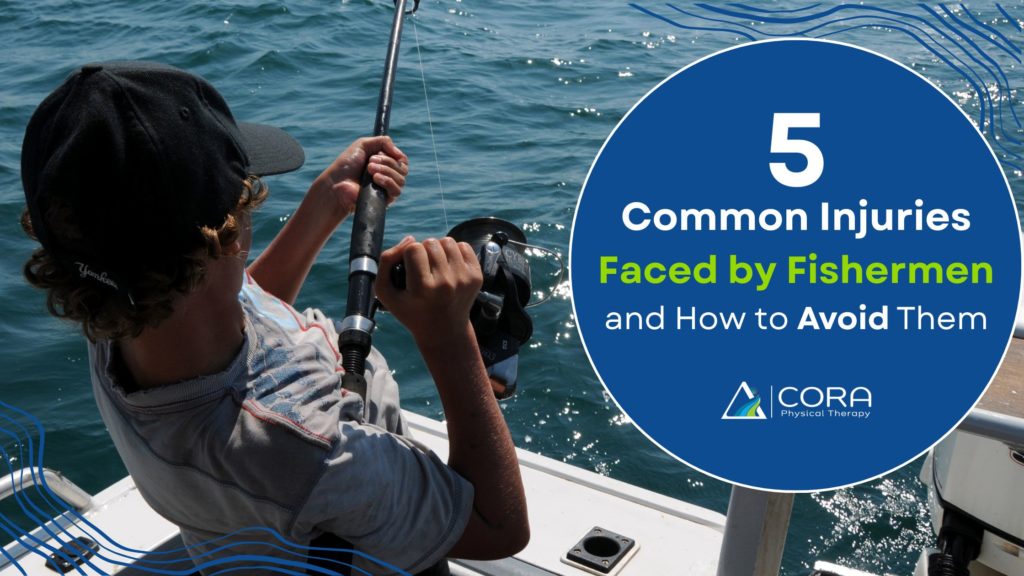
Summer provides the perfect weather to grab the tackle box and enjoy fishing at your local watering hole. Before casting your line, here are a few common fishing injuries to understand and take steps to prevent.
The tradition of fishing predates recorded history and remains one of the most popular forms of recreation and food gathering in the world. The commercial fishing industry supports more than 1.7 million jobs in the U.S. and generates more than $200 billion in annual sales.
1. Slips, Trips and Falls:
Just like in homes, offices or retail environments, the most common fishing injuries can be attributed to clutter and clumsiness. While some of this is just part of the human condition, a lot of risks can be mitigated with better gear.
Let’s start from the ground up. Flip-flops, sandals and water shoes have minimalist designs and are made from synthetic materials that dry easily after getting wet. However, they also lack the supporting material of sneakers or boots and are less likely to have treads that anchor a fisherman to the boat deck or dock. This can lead to loss of balance and impact injuries from hitting hard surfaces, as well as foot strain injuries from the lack of support.
Whenever possible, wear close-toed shoes or boots that have strong, rubber grips. It is also a good idea to add grip strips to the surface of the dock or deck to ensure that the rubber has a high-friction contact point and keeps you in place.
2. Neck Injuries:
Aside from slipping and falling, it is possible to hurt your neck muscles through the rigors of fishing. This typically occurs when battling a fish on the line, which forces your body out of alignment. Whenever possible, remember to keep your nose over your knees, over your toes to ensure that muscles are not exposed to undue strain.
Another practical prevention method is to stay limber and physically aware while fishing. Dynamic stretching, including knee-to-chest and arm circles, can help ensure that your muscles are ready for the strain of battling a fish (more on that below).
It also helps to stay hydrated, avoid excess alcohol, and be aware of the drowsiness or vertigo that can happen as a side effect of Dramamine, a popular anti-motion-sickness medication.
3. Lower Back Injuries:
Backs are not designed to handle the rigors of a battle, as larger fish can dive hundreds of yards into the depths at speeds of 40 or 50 MPH. It might be a bit more surprising to know that a Duke study revealed rampant lower back pain in fly fishermen as well, due to the constant repeat of their casting.
One tip for winning the battle and saving your back is to avoid twisting under pressure. It’s tempting to pull the rod back from the water’s edge, twisting to the right or left. This overloads the pressure on one side of your body, greatly increasing the chances of injuries. A second tip for saving your back is to get low, using a lower center of gravity for mechanical advantage. This can include sitting or bracing yourself against a barrier.
The last practical tip for saving your back is to use a belt pole holder to anchor the pole to your abdomen. Then, much like lifting a heavy box, keep your abdominal muscles tight and shift the strain from your lats, shoulders and arms down to your glutes and quads.
4. Overuse Injuries:
Carpal tunnel syndrome and lateral epicondylitis, more commonly known as tennis elbow, are injuries caused by overuse of fine motor skills. Through the meticulous process of stringing a line, baiting a hook, casting, reeling and battling with a fish on the line, fishermen are primed for the muscle fatigue that leads to these types of injuries.
Large muscles are also prone to overuse injuries, including bicep tendonitis and rotator cuff strains. Located in your shoulder, your rotator cuff gets a workout through the dozens or hundreds of line casts during a day of fishing. Similarly, repeatedly reeling in a line, especially with a fish on it, can lead to bicep soreness that takes a while to heal.
When fishing, be sure to stay limber and hydrated, using dynamic arm stretches to loosen up the connective tissue in your back, shoulders and arms. Rest, or placing the pole in a fixed holder, is another good way to take a break from the constant engagement of these muscles.
5. Sprains and Strains:
Most physically fit people understand how much weight they can responsibly lift without risking injury. Fishing is unique in that it’s impossible to know how much you’re lifting and for how long.
Even if it costs you the fish, it’s important to have an exit plan when battling with a fish on the line. Underneath the water’s surface, it’s impossible to know how much the fish (or shark, seal, whale, etc.) might weigh and what they are physically capable of. If you feel your muscles or connective tissue start to fail and have sharp pain, that is a time to hand off the reel (if possible) or let the fish go. Pain is the body’s natural way of informing us that something is wrong.
Even stories where you don’t land the beast make for great fish tales.
We’re Here to Help, Before and After:
Physical therapy is a great way to diagnose, rehabilitate existing injuries, or prevent them from happening in the first place. While there is always a risk of fishing injuries, our team of highly-trained CORA therapists will ensure you perform and feel your best before and after your day on the water.
If you enjoy fishing in North Carolina, South Carolina, Virginia and Florida, reach out to your local CORA clinic today to set up a complimentary screening for injury, or work with us to develop an independent exercise routine that helps you land the big one.








